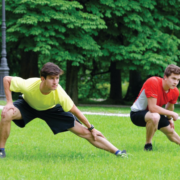Tennis Techniques to Avoid Sports-Related Injuries

By Eli A. Finkelstein, MD
 In Atlanta and its neighboring communities, tennis continues to be a popular sport athletes at all competitive levels turn to in order to remain healthy and maintain an active lifestyle. At Resurgens Spine Center, we applaud this attitude and strive to educate athletes on how to fulfill their passion for sports safely.
In Atlanta and its neighboring communities, tennis continues to be a popular sport athletes at all competitive levels turn to in order to remain healthy and maintain an active lifestyle. At Resurgens Spine Center, we applaud this attitude and strive to educate athletes on how to fulfill their passion for sports safely.
Tennis is a sport that has the potential to cause injury to any portion of your spine. Commonly, shoulder, elbow, and knee injuries can occur. However, between 20 to 25% of all sports-related injuries affect and include the spine. Tennis, in particular, causes repetitive impact to your spinal column. Serving, forehand, and backhand strokes all require a large degree of acceleration and deceleration in the body, as well as trunk and spine rotation. These movements typically require quick positional changes that put stress on the small joints of the neck and low back, compress disks, and overwork the muscles, ligaments, and soft tissues that aim to support your spine.
Here are three tips to keep you on, versus off, the tennis court.
PREVENTION
Prevent spinal and other orthopedic injuries by performing proper warmup and cooldown exercises to prepare and recover your body. By stretching and loosening up muscles, joints, disks, and other soft tissues, you are less likely to experience strains, joint sprains and spinal injuries. For the best results, consult your doctor to assist in finding the best routines for you. Assure that your racket works for you. A more rigid racket with less string tension will reduce spine torque and trunk rotation, whereas a flexible tennis racket frame will require more trunk rotation and potential spinal pain and injury. It is important to have the correct racket handle size, not only to avoid “tennis elbow,” but also to prevent changing the biomechanics of your swing, which will ultimately stress your spine.
FORM
Use proper form when playing. Serving, in particular, creates significant stress to your spine. Consider a slice serve in place of a kick serve to reduce risk. A coach or tennis “pro” can be an excellent source of education to assure your technique is matched up with your physical attributes and to avoid the onset of new or worsening of chronic injuries.
HARD VERSUS SOFT COURT
The type of court you play on can have an immense impact on how much punishment your spine will take while playing. Hard courts require more agility, speed, reaction time, and most importantly, absorb less shock. Soft courts may be a better choice when available. In addition to absorbing the abrupt start-and-stop nature of tennis, clay and grass surfaces allow you more time for proper body positioning, therefore assuring better technique and less risk of injury.
Tennis is a game that tests your agility, endurance, and ability to think quickly on your feet. Because of this, injury prevention must remain in the forefront to any athlete wishing to participate. To reduce your chances of causing injury to your spine, follow the tips above.
Resurgens Spine Center • Non-surgical & Surgical Spine Care • 24 Convenient Atlanta Locations • www.resurgensspine.com



